Catalogo:
Circo Apollinare di Domizia. «Procopio nel lib. della guerra Gotica.» Furono dissotterrati diciotto anni fa le rovine di questo circo nel situ, ove l'abbiam delineato, ed ove son state dinotate dal Nolli nella sua pianta di Roma moderna. Di esse parla il Fulvio, ove dice: «Vi resta per anco fuori di porta Castello, in quelle vigne vicine, non lungi dalla mole Adriana una piccola forma di un circo di pietra nera e dura quasi affato rovinato.»
Circus Apollinaris of Domitia «Procopius in his book on the Gothic War.» Eighteen years ago, the ruins of this circus were uncovered (typo in the Italian, either yours or printer's: dissotterrate) at the site where we show it, and where they have been noted by Nolli in his map of modern Rome. Fulvio speaks of them, where he says: "There remains in addition outside the Porta Castello, in the nearby fields, not far from the Mole Adriana [Hadrian's Mausolem] the shape of a small circus in hard black stone, pretty much ruined in fact."
Vincenzo Fasolo, "The Campo Marzio of G. B. Piranesi".
2691a
2691d
1956
Tafuri text
1996.09.02
one more Piranesian daze: circus act
2000.05.15
In attempting to discern the possible reason or message manifested by the plan changes to the Circus of Caligula and Nero and to the Circus Agonalia, I began to think of these specific circuses and how they may or may not relate to the numerous other circuses delineated throughout the Ichnographia. Within the version of the Ichnographia that is presently widely published there are six circuses, the Circus Caji et Neronis, the Circus Agonalia, the Circus Hadriani, the Circus Domtiae, the Circus Flaminius, and the Circus Apollinaris. With only minor adjustments to length, each circus is delineated in a virtually identical fashion, and, moreover, each circus reflects an archaeologically correct circus plan. As already illustrated, the plans of the Circus Caji et Neronis and the Circus Agonalia within the University of Pennsylvania Ichnographia reflect more stylized, i.e., archaeologically incorrect, circus formations. Since all the circuses are identical in the widely published version of the Ichnographia, I then began to wonder, via transposition, whether all the circuses within the Penn Ichnographia were likewise identical there in the form of exhibiting plan changes. In all honestly, I had not noticed any plan changes to the circuses other than the Circus Caji et Neronis and the Circus Agonalia the two times I had seen the Penn Ichnographia prior, but nor did I have any pictorial hardcopy evidence that there are no other plan changes. Having worked with the Ichnographia for over ten years, if I have learned anything, it is that the Ichnographia, no matter how well you think you know it, continually maintains the uncanny ability to beguile. Therefore, it was necessary for me to once more return to the other Ichnographia.
Upon doing further research, i.e., going back to the University of Pennsylvania's Fine Arts Library to again scan the Ichnographia Campus Martius, more plan changes were indeed discovered, and, just as I had begun to suspect, the "change of plans" effected the Circus Hadriani, the Circus Domitiae, the Circus Flaminius, and the Circus Apollinaris. Thus, it is now evident that each of the major "changes of plan", between the Ichnographia Campus Martius that is widely published and the Ichnographia Campus Martius within the rare book collection at the University of Pennsylvania's Fine Arts Library, occur more or less exclusively within those buildings of the Ichnographia labeled "circus".
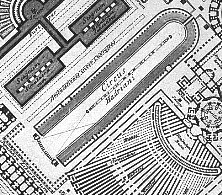 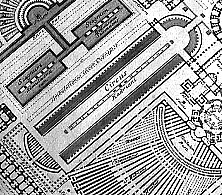
The plan above left is the Circus Hadriani as it appears within the commonly reproduced Ichnographia. Above right is the Circus Hardiani as it appears within the Ichnographia at the University of Pennsylvania.
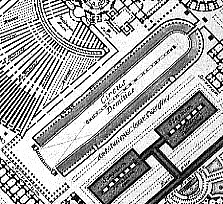 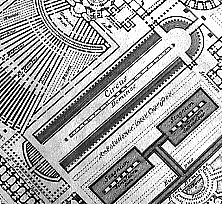
The plan above left is the Circus Domitiae as it appears within the commonly reproduced Ichnographia. Above right is the Circus Domitiae as it appears within the Ichnographia at the University of Pennsylvania.
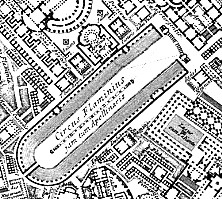 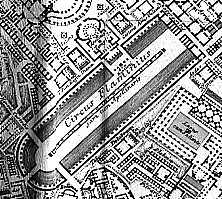
The plan above left is the Circus Flaminius as it appears within the commonly reproduced Ichnographia. Above right is the Circus Flaminius as it appears within the Ichnographia at the University of Pennsylvania.
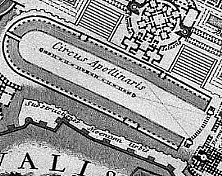 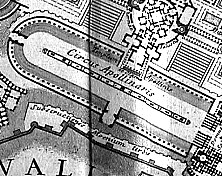
The plan above left is the Circus Apollinaris as it appears within the commonly reproduced Ichnographia. Above right is the Circus Apollinaris as it appears within the Ichnographia at the University of Pennsylvania.
As the above plan comparisons indicate, the newly discovered circus plans engage directly with their neighboring buildings, thereby rendering a connected contextualism and demonstrating a more integrated urban planning methodology. The circus plans of the commonly reproduced Ichnographia on the other hand, albeit archaeologically correct, do not engage their immediate surroundings, and appear as though literally afterthoughts. Beside the already mentioned questions as to what these changes might mean and which set of plans came first, or what Piranesi's intentions in making the changes might have been, there is now an additional question as to why the changes were specifically and only applied to the Campo Marzio's six circuses.
| |

Circus Domitiae as delineated within the first state of the Ichnographia Campus Martius.
another Piranesian daze
2000.05.16
...went back to again scan the Ichnographia Campus Martius, and just as I'd begun to suspect, all the circuses within the Ichnographia show a change of plan. ...the circuses of the Ichnographia in its common version are more archeologically correct.) ...the circuses of Hadrian and Domitiae as represented in the frontispiece comply with the "uncommon" circus plans...
The place where the bodies of the dead were burned and buried under Hadrian
2001.07.18
Even though the Circus Domitiae is a creation of Piranesi's imagination, he nonetheless lists the building within the Catalogo section of Il Campo Marzio dell'Antica Roma, which is where all the buildings of the ancient Campus Martius are listed along with their ancient textual references:
Circo Apollinare di Domizia «Procopio nel lib. della guerra Gotica.» Furono dissotterrati diciotto anni fa le rovine di questo circo nel sito, ove l'abbiam delineato, ed ove son state dinotate dal Nolli nella sua pianta di Roma moderna. Di esse parla il Fulvio, ove dice: «Vi resta per anco fuori di porta Castello, in quelle vigne vicine, non lungi dalla mole Adriana una piccolo forma di un circo di pietra nera e dura quasi affatto rovinato.» This translates as:
Circus Apollinaris of Domitia «Procopius in his book on the Gothic War.» Eighteen years ago, the ruins of this circus were uncovered (typo in the Italian, either yours or printer's: dissotterrate) at the site where we show it, and where they have been noted by Nolli in his map of modern Rome. Fulvio speaks of them, where he says: "There remains in addition outside the Porta Castello, in the nearby fields, not far from the Mole Adriana [Hadrian's Mausolem] the shape of a small circus in hard black stone, pretty much ruined in fact."
What Piranesi does here is transpose the evidence of the Circus of Hadrian for that of the Circus of Domitia. This is just one of many mistakes throughout the Campo Marzio publication that actually signifies an inversion of the truth rather than an occurrance of factual error. It is as if Piranesi is continually defying his critics in that 'mistakes' can be readily found, but that these inaccuracies are harbingers of further meaningfulness via inversion has heretofore remained unnoticed.
Re: Piranesi
2003.01.02 16:20
Hi Sue,
Thanks for sending a copy of the Piranesi essay. I haven't read it all yet, but I like the fullness of the histories provided. A couple corrections are necessary, however.
The complex behind Hadrian's tomb includes the Circus Hardiani and the Circus Domitiae, which is a circus made-up by Piranesi and named for Domitia, Nero's great aunt who once owned much of the property that is delineated upon--Nero got the property and added it to the Imperial holdings. Note also that Piranesi labels the area Horti Domitiae, which was the name of the place once upon a time.
Traditionally, the Triumphal Way prepared /started in the Campo Marzio and made its way to the Triumphal Arch, where the procession entered the city proper. There are no archeological remains of the Triumphal arch/gate, thus some believe it was either closed until a triumph or that an opening in the Severian Wall was manifest with each triumph. Piranesi has the triumph preparing in the Vatican Valley, thus playing with the inverting history of the Triumphal Way when, after Christianity was Imperially sanctioned, the processions ended at St. Peter's. [The whole double sided nature of Piranesi's delineation of the Triumphal Way within the Ichnographia was addressed in "Inside the Density of G.B. Piranesi's Ichnographia Campi Martii," the paper I presented at Brussels, 1999.]
Steve
|